Two weeks of world-class tennis in Istanbul ended on Sunday, first the TEB BNP Paribas Istanbul CUP (WTA) on the last week of April, followed by the TEB BNP Paribas Istanbul Open (ATP) on the first week of May, both taking place at the Koza World of Sports facility in the Esenyurt neighborhood of the greater Istanbul area. I was not here for the Istanbul Cup due to my obligations in my “other” life, but I made it to my hometown on time to catch all the action during the Istanbul Open. Everything that follows, with regard to the attendance woes of the tournament, will be based on my observations during the Istanbul Open. I will add that many people that I know have told me that same type of issues also existed during the previous week, albeit not as blatantly, thanks to the success of two Turkish WTA players reaching the quarterfinals.
My friends, and those who follow me, know that I show great interest in the organizational structure and planning of tournaments, and talk about them often. It is what I plan to do in this article. Istanbul is my hometown, where I was born. I come from the tennis world of the city. I grew up as a tennis player in this same milieus. I want this tournament to succeed. I want the stands to fill up. So, I write a bit more passionately about it than I have for most other tournaments. It may seem like a long post, but there are a lot of pictures and embedded tweets used to clarify the talking points for you, the reader. Having said that, let’s move on to the topic at hand.
There are many contributing factors to the tournament drawing very little amount of on-site spectators. Furthermore, none of this is new. This problem existed in the tournament’s inaugural year 2015, brushed under the carpet thanks to the Roger Federer frenzy that carried the week, and it continued in 2016:
What's with low attendance at #tebbnpparibas #istanbulopen #atp ? There are more people at my place, and I live alone.
— acestroke (@acestroke78) April 28, 2016
The attendance was a painful issue, once again this year, leading to some people commenting on it on social media. It just looks bad when the stands are empty, and I really mean empty, day after day, match after match.
Full house in Istanbul 😳😳😳😳 pic.twitter.com/znmOG6025u
— galo blanco (@galo_blanco) May 4, 2017
ATP Tournament in Istanbul vs WTA Tournament in Prague pic.twitter.com/93DHHuNiZL
— Lodo (@lodotennis) May 4, 2017
It was only on the final Sunday, thanks to two top-10 players meeting for the title and the completely unexpected success of Tuna Altuna, a local player who generated much-needed energy by reaching the doubles’ final with his partner Alessandro Motti, that Koza WOS Arena filled up around little more than half-way, between 4500 and 5000 people.

I know 6,700 was the official number given but if you were there, you knew that was an inflated number, in the same way that some universities inflate their attendance numbers above the actual ones through various methods (attendance vs ticket sold vs turnstiles turned, etc) in the College Basketball world of the U.S.A. Yet, nobody who was there all week can deny that “little-more-than-half-full” was a beautiful sight compared to previous days. Here was the attendance on the Raonic vs. Tomic quarterfinal match, at 7 PM on Friday evening:
There is one major contributing factor to this problem, one for which there is no solution in the foreseeable future. The facility is simply too far away from the rest of Istanbul. The Ataturk airport is considered “away from the city center” by many life-long Istanbulites and the tournament site is a considerable distance past the airport. To give you an example, I drove every day from Camlica neighborhood, on the Asian side of Istanbul, but only a few minutes away from the Bosphorus Bridge (the oldest and the busiest of the three bridges that now cross the two continents). It took me anywhere from 1 hour, when I would drive past 10 PM, to over two hours during the day just to go one way! There are a ton of tennis fans living on the Asian side, much further from the bridge than I do, and it takes them longer just to reach the bridge, i.e. add roughly an hour to the trip. People living in the busy neighborhoods of Levent, Etiler, Nisantasi, Bebek, Istinye on the European side, probably spent roughly the same amount of time on the road going one way, meaning it could possibly be a three-to-four-hour affair to go back and forth to the tournament for most of those people. It is thus, a pain to get to the location, a major pain!
Yet, this problem is here to stay. The facility is owned by Garanti Koza, a successful land development company with far-reaching resources part of which they use generously, to their credit and they should be applauded for this, to help the development of Turkish tennis. Furthermore, the construction continues on site to transform it into a state-of-the-art, world-class sports facility. It’s their facility, their point-of-pride (understandably), the tournament is not moving anywhere else, thus the unsolvable problem of location. Istanbul’s infrastructure and the urban public transportation system are simply not there to ease the burden either.
There are, however, smaller issues that exacerbate the problem, ones that are indeed solvable. Let’s keep in mind the central issue: the lack of attendance. Thus, in order to at least ease the burden brought on by uncontrollable factors, one must do all else that remains within one’s power to counter the effect. For example, one can take measures to make the experience pleasant for those who do indeed decide to come, so that they will come back, and encourage others to do so. What should be the primary goal? To make every effort possible to let people know the different ways with which they can get to the site, inform them, do it frequently, do it visibly, and most importantly, do it clearly!
First, it starts with the official website, the number one source for the dissemination of information about the tournament. Let me first point out that the website is an improvement from two years ago, the last time I attended the tournament. It’s nicely designed and has both English and Turkish pages. However, once again, remembering the number one obstacle you are fighting, and the fact that anyone who decides to attend the tournament probably never heard of the site, should the instructions on how to get to the site not be the first thing that appears on it? You type in the web address to Istanbul Open’s homepage, and even if you make the browser full-page, you still don’t see it. You have to scroll down to get to the link that tells you how to get there. In other tournaments, this may be acceptable, but not when the location of your tournament is perennially the main reason why you can’t get people to come out. When I tweeted about the public transportation problem (by which I meant the city’s public transportation system), the tournament director Paul McNamee was quick to point out to me that my tweet was inaccurate, that there was transportation offered (again, my post was about public transportation system and the city’s infrastructure, not the tournament’s sponsor-arranged transportation specifically for the week, but ok..), and had his assistant’s*** phone opened up to the page on which it shows the transportation points, and had her show it to me. That link, more specifically, what it shows on that link, should be the glaring, unmistakable information staring at the person who just arrived to the home page. If not, at least a big bold link saying “Click here for Transportation schedule” should show up, and not be on the lower portion of the page with three other links of same size, where one must scroll down to see. Attendance and location are your main problems: then, make your instructions on how to get there easy-to-reach and visible.
***I will not go into the details of the short dialog that took place between her and I, but anyone involved in public relations of a tournament should have better communication and/or social skills, should definitely keep the second sentence that she said to himself/herself, if anything at all, certainly not say it to a media member (my badge clearly showed that I was), who could easily make a flashy heading for an article, if he/she had bad intentions or aspirations of high clicks or ratings, at the cost of making the tournament look bad (plenty of those around, believe me).
Second, announce relentlessly and continuously that a sponsor has arranged transportation to the tournament site from two key spots in Istanbul. People who use regular public transportation do not automatically become aware of this, because it is not part of the public transportation system. Don’t announce it on the tournament’s facebook page only once, on April 27th, before the Main Draw of the tournament even begins, and then never post it again! Don’t wait until Wednesday of the tournament to announce it for the first time, and the only time, on tournament’s Twitter page! Announce it on social media at least once or twice a day throughout the tournament. Tweet it, Facebook it, Instagram it, tell the broadcasting TV station to remind it to the viewers, every single day, every morning and evening, and get others to do it. Why? Because nobody knew until then about the arranged transportation for the tournament. Here is a great idea to remedy the problem, at least partially, and yet, it is not announced properly. When I was made aware of it, I asked as many people as I could, including people in the world of tennis in Turkey and regular attendees of the tournament, and not a single person said “yes I knew that they set up transportation for this week.” Nobody until that point (we had the conversation on Wednesday) mentioned it either when the lack of attendance was the topic of conversation because, again, they did not know. One facebook post on April 27th and one Tweet on May 3rd are not enough for a tournament taking place throughout the first week of May. When I found about it on Wednesday (May 3rd), I began tweeting about it, underlining it constantly on TV (I was doing daily commentary on the TV station broadcasting the tournament), turning to the camera and literally appealing to the people of Istanbul, to look at the website for the transportation schedule, every day. Yes, I received some feedback from regular listeners and followers saying “thanks” and that they did not know. Unfortunately, I was the only one relentlessly repeating it on either the social media and on TV for people to come and look to the website for transportation schedule. I did not see the same diligence from tournament organizers other than a tweet or two at the most for the rest of the tournament. Below is a tweet from a devoted tennis fan, who had discovered the arranged transportation on that Wednesday, informing other people on the exact location of the bus (translation: “by the Migros located under the stadium”). The website link simply says “by the stadium,” which happens to be Fenerbahce’s big home stadium (50,000+ capacity) and “by the stadium” could be anywhere around it. Good luck walking around that stadium to find the bus. Yes, specifics indeed matter. (Side note: This tennis passionate told me there were only 8 or 9 people in the bus)
Kadıköy'den Garanti Koza Arena'ya giden servisin yerini merak edenler için, stadın altındaki Migros'un önünde bekliyor. #IstanbulOpen pic.twitter.com/DAqfnsNs9A
— TenisNot (@TenisNot) May 5, 2017
Third, make the instructions on how to get there – let me put it in bold letters again – clear! Do not simply assume that everyone owns a GPS-abled phone. It is not enough to instruct those who depend on the directions from the website, to simply “take the Esenyurt Toll Booths exit to reach Garanti Koza Arena” (or the equivalent of on the Turkish version of the page). It is inaccurate, incomplete, misleading, and lazy. You can’t even see toll booths at the exit that you must take, nor does it say anywhere at the exit that there are toll booths. And once you miss the exit and keep going straight on that highway, you end up seeing the tolls on the right. By then, it’s too late, you can’t turn, and there you go swirling around in complicated traffic for another 15-to-20 minutes. If you did manage to take the exit, you don’t just “reach the Garanti Koza Arena.” There are few more turns and splits on the road. The sentence “take the Esenyurt Toll Booths exit to reach Garanti Koza Arena” is anything but accurate. Make the tournament site clear to those who drive up. Have big signs telling people where to turn, and have them at several points, all the way from the toll booths. Perhaps, it’s better to show in pictures:
1) Here is the first time you see the exit as you approach it. As you can see, there are no toll booths within sight, and not even the word “Esenyurt” in this first sign.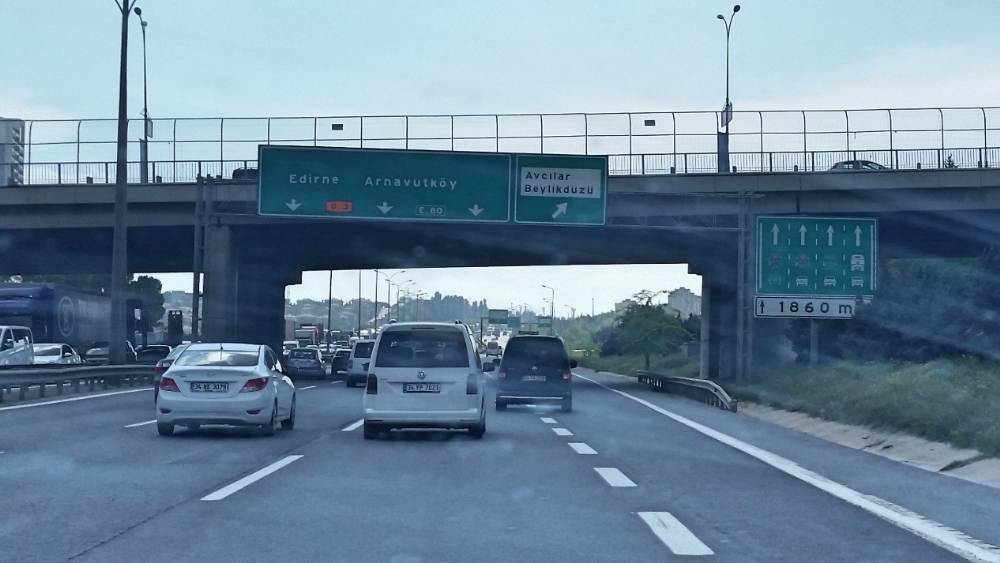
2) Then as the exit separates, there is a second sign with Esenyurt on it, but still no toll booths, nor can you see any in the distance. If you remain on the highway (left side) you are lost for 15-20 minutes.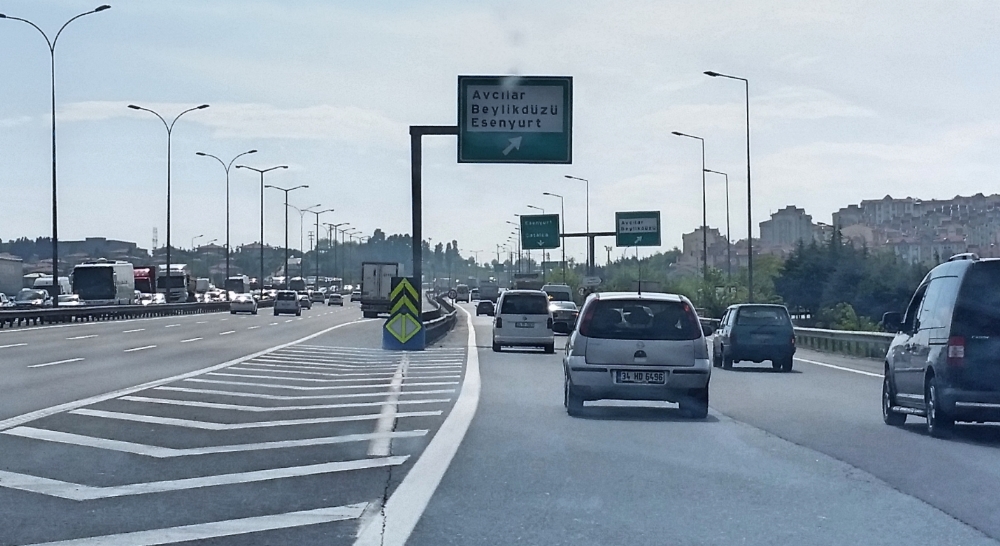
3) If you made it to the toll booths, once you pass them, you come to another road split. It says to go right for “Esenyurt.” You must NOT! You need to stay on the left, which you would not know to do, especially that the site is announced as being located in “Esenyurt.” Now pay attention to the two small signs under the big Esenyurt traffic sign, to the left of the ambulance. The smaller of those signs, the lower one, tells you in small letters to go left for the Istanbul Cup and Istanbul Open. Unfortunately, they are impossible to see if you are driving as you can see from the image, unless you are right up close to them at which point you have already committed to the turn and cannot go back. Could these signs not have been larger? Or better yet, could this not have been explained on the directions rather than saying “take the Esenyurt Toll Booths exit to reach Garanti Koza Arena”? 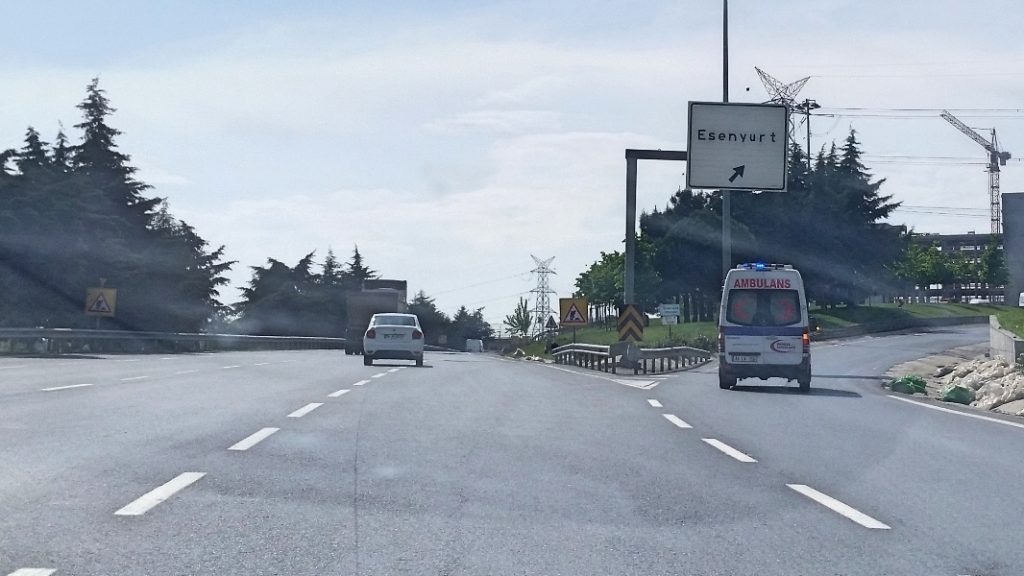
4) You eventually notice the large Koza WOS Arena on the far right (if you have seen pictures of it), so you feel that you may be approaching. But right here, you must turn right and not go straight (and get lost for another 10-15 minutes), which you could easily do since the Arena straight up the road, on the right side. Again, that “invisible-from-your-car sign” tells you go right, if you can see it while you are driving while frantically trying to figure out where to go. I circled it in orange so you can see which sign I mean. The bigger letters at the bottom say “Parking” and the smaller letters at the top say the names of the tournament (shouldn’t at least that be reversed?). Good luck seeing that from inside your car, which is where I was, when I took this picture.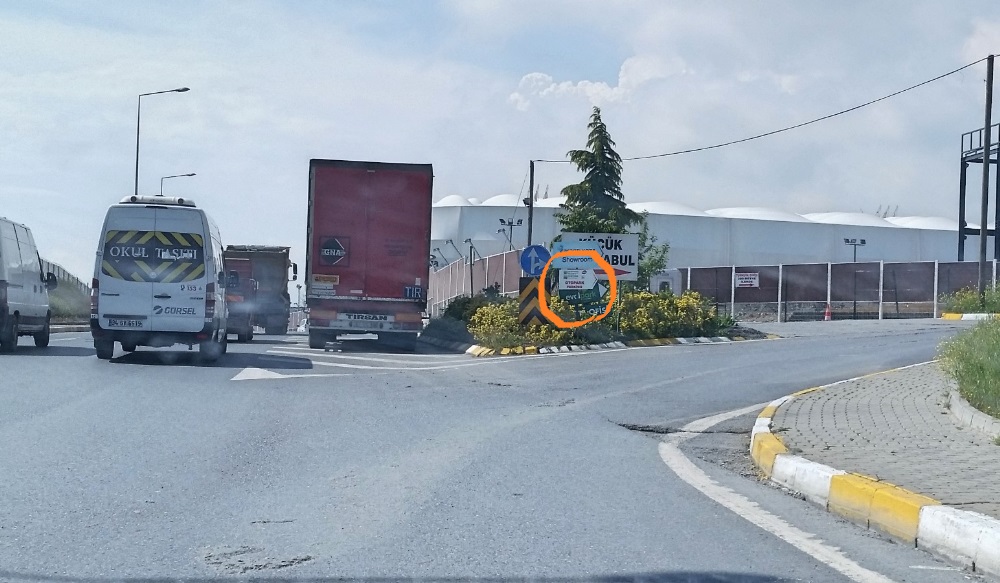
Fourth, and once and for all, please have a big banner, or some sort of a large sign showing anyone who drives up that there is actually an entrance to the ATP Tennis event taking place, “TEB BNP Paribas ISTANBUL OPEN.” This was the case in 2015, and two years later, there is still not a ‘visible-to-everyone sign’ indicating that you have actually arrived at the entrance of a world-class tennis event! I literally saw dozens of people asking others in buildings nearby where the tournament is, when they were but 50 meters away from the entrance, because they cannot see it. The site is continuously expanding, therefore, there is the constant noise and appearance of construction in the area. This is simply not a pretty sight when you first drive up. It was not in 2015, it is not now. But that is understandable since a world-class sports facility is under construction. However, it is no excuse to make the simple process of parking and finding the entrance to the tournament feel like yet another obstacle. Here are more pictures to clarify further:
1) Let’s pick up from the right turn in the last picture above. This is what you see once you have turned. Now the tournament’s entrance is about 60 meters to the left. Can you tell? Nor can anyone else unless they have already been there or unless they see a big sign of the tournament at the entrance. But, alas..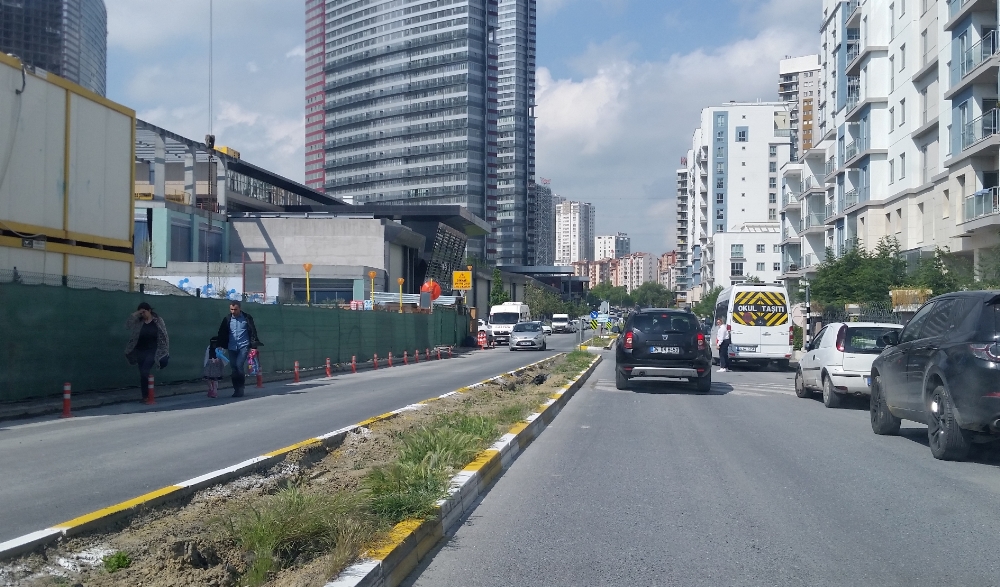
2) Here is the same street, driving from the other site. The tournament entrance is now to the right, between where the van and the two buses are parked. Again, can you tell? Nor can anyone else coming from this direction. Would a giant, high banner saying “Istanbul Open” help? You bet! 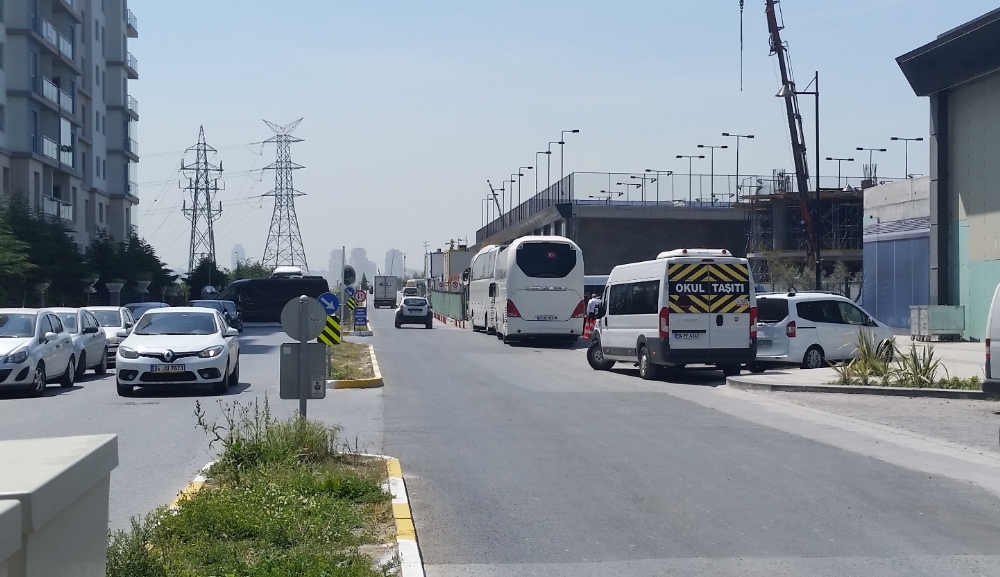
3) I will simply ask the question: Should the entrance to an ATP Event look like this? There are again, two of those small signs on each side, with the words “Turnuva Alani” (meaning “Tournament Area”) added. They are hard to see from your car anyway as you drive past them (and not easy to read unless you are up close to them), and then, they are blocked by people at times(because they are only at about hip-level), or by vehicles at others. 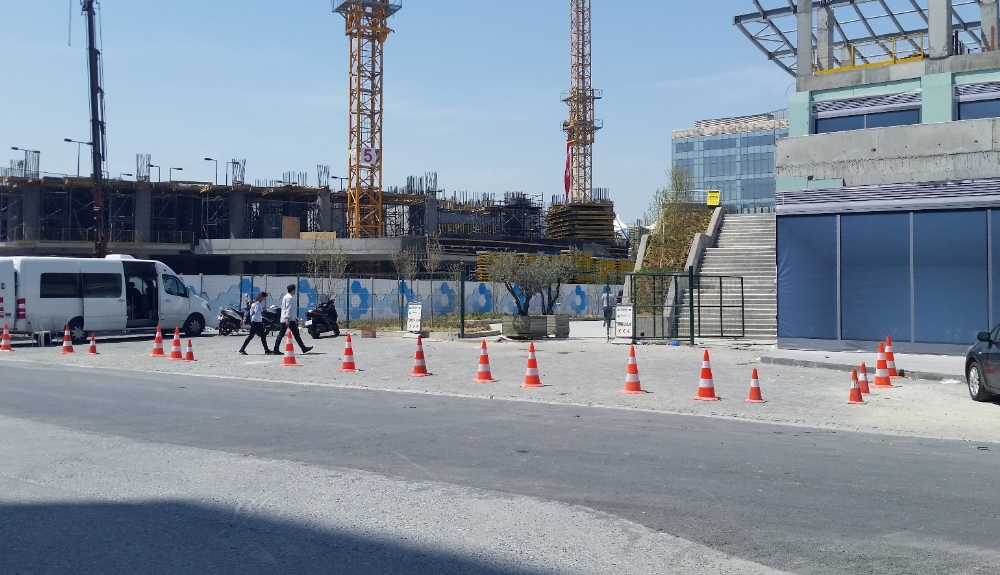
4) The next four pictures illustrate what you see once you walk past the above entrance. (a) You walk a straight path during which you see blue signs ahead saying the tournament’s name, so at least now you know you are headed in the right direction.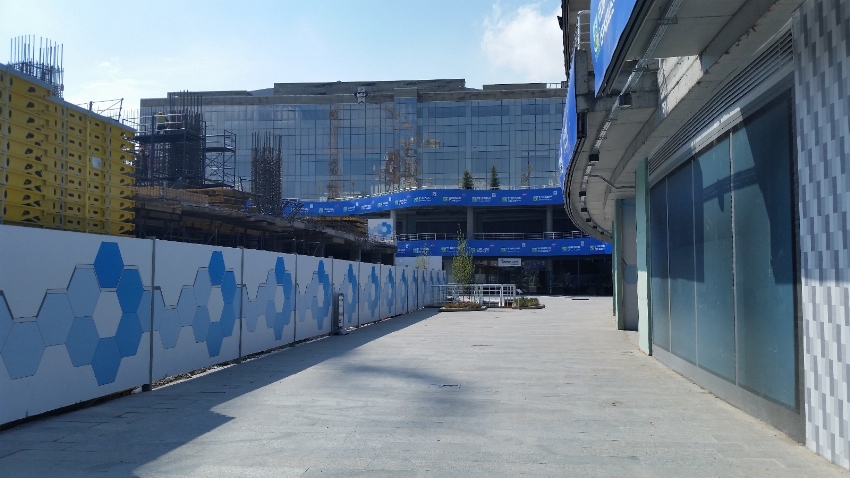
(c)Finally, at the top of the second escalator, you arrive to the security and ticket check. 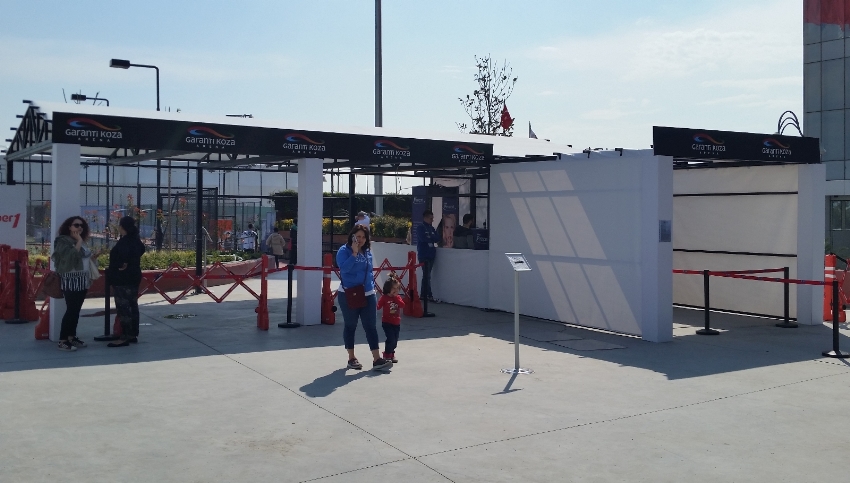
(d) After you go past that, the outside courts are on your left and right, and the impressive Koza WOS Arena is staring at you straight ahead.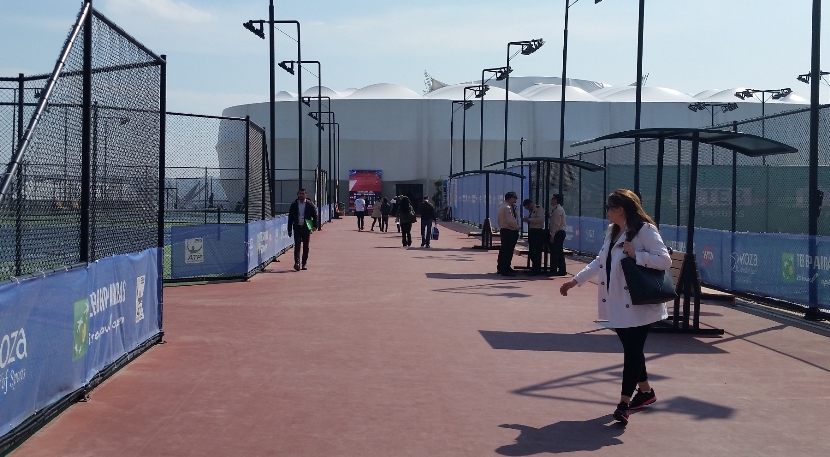
The outside area of the tournament is nothing exceptional, but the Koza WOS Arena itself is a wonderful show court to say the least. The players like it, the structure is stunning, and it has a retractable roof. Overall, the tournament is a definite improvement from its inaugural 2015 edition. Paul McNamee, whose tennis past should prove by itself that he is vastly qualified for such position, is obviously an excellent choice as the tournament director. The field of players was also great, featuring two top-10 players in the finals, which happened in only three other ATP 250 events in 2016 and 2017 so far. The players were thankful of how well they were taken care of during their stay. Credit goes to Paul and others who made it a pleasant experience for them.
Nevertheless, there is more to a tournament’s success than the players, and it needs to be a team effort. One person cannot do it all. In all fairness, I would speculate with a certain amount of comfort (for the record, I haven’t talked to him about all this specifically, not that I have not tried) that Paul probably faces the same daunting challenges that the previous two tournament directors faced: trying to make things work in a situation where many elements are out of your control, and sometimes, people to whom you delegate responsibilities do not exactly “get” what you expect them to do in the day-to-day operations.
One must, however, and again I keep coming back to the number one problem facing the tournament – the empty stands -, diligently attack the things that one can fix. Yet, some of the problems I foregrounded above have existed since the first year of the tournament. They are indeed fixable. Once you take care of these (solvable) problem, therefore negate some of the negative effects of the site’s geographical location (the unsolvable problem), and you manage to add a certain amount of a “pleasant” experience to the process of attending the tournament, people may come in larger numbers. It would certainly be worth the effort in order to make attendance numbers improve. But if people have to battle extra elements on top of simply driving/riding for a long time, just to get to the vicinity of the site, they are unlikely to come back, and highly unlikely to talk positively about it to their friends and acquaintances.
I remain hopeful for the years to come.

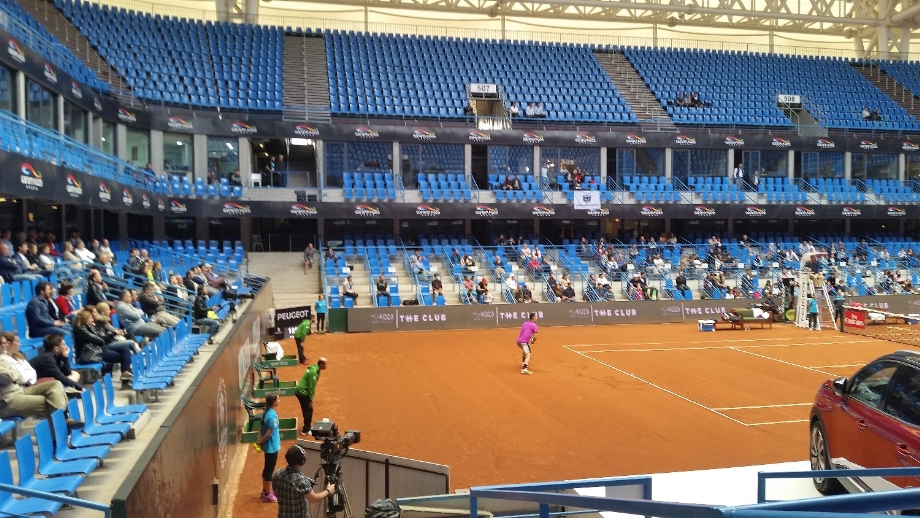
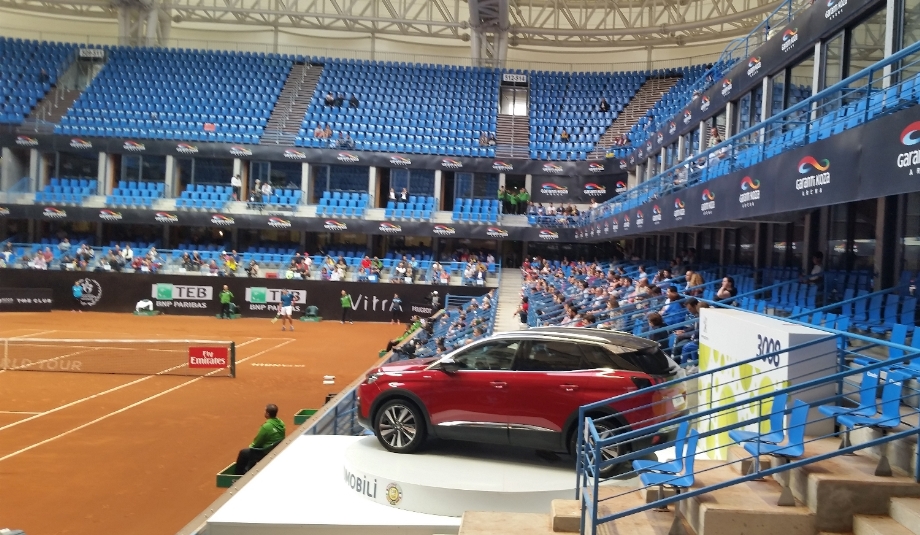
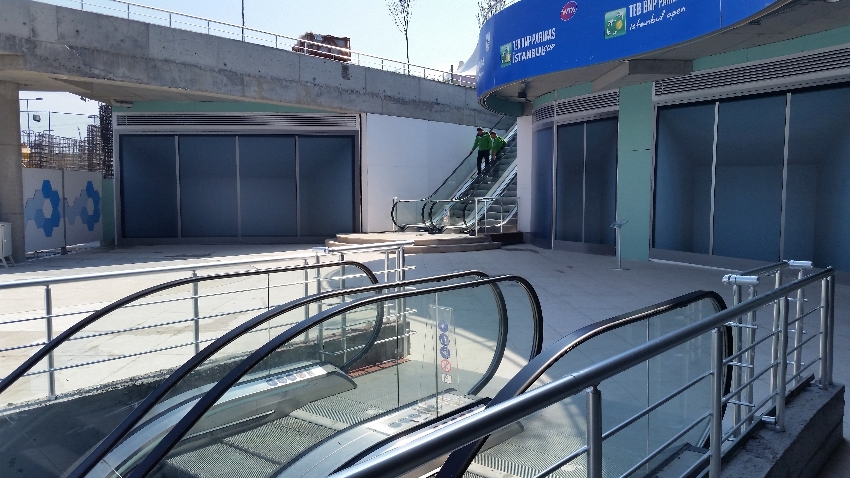
Mert,
Reading your article definitely made one thing very clear to me. If I was to travel to the tournament on my own and not being familiar with the roads, I would have absolutely got lost a hundred times and got an ulcer at the same time.
The bottom line is there are too many inexperienced people trying to organise these tournaments and as long as this goes on, unfortunately both tournaments will never be a success.
The only reason both these tournaments haven’t been taken off the calendar by WTA and ATP, because the owner of Garanti Koza pumps millions into the coffers of these organisations.
Trust me if the owner of Garanti Koza relied on money coming in from sponsors and ticket sales, both these tournaments would have gone broke a long time ago.
Re your last sentence of being hopeful for years to come, I hate to break the news to you, however the only way crowds will turn up if Federer plays every year at the tournament until he retires and since that’s never going to happen, you have a better chance of winning the lotto 🙂
Once again thanks for your article. It was very informative and good luck at the French Open.
Umit